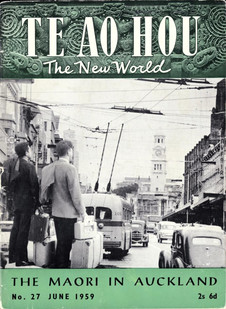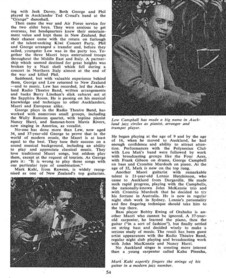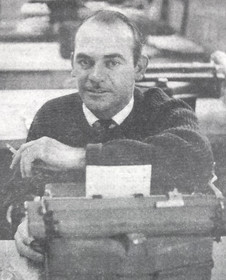This article, by Auckland show business reporter John Berry, appeared in Te Ao Hou, June 1959. While its tone now seems paternalistic it captures a era in which Māori musicians were key players in a newly sophisticated nightclub scene.

Mark Kahi, Lew Campbell, George Campbell. - Te Ao Hou, June 1959 / Papers Past
In Auckland’s plushest night club, amid an atmosphere of candlelight and exotic foods, a young Māori began to finger the keys of a piano. Beside him, the bass player and guitarist joined in. Tourists, wealthy businessmen and sophisticated men-about-town looked up from their shrimp cocktails, their deep-fried chicken or their T-bone steaks as the three Māori weaved fascinating patterns of sound.

Te Ao Hou was a bilingual quarterly published by the Māori Affairs Department from 1959 to 1975. As well as covering current affairs, it occasionally reported on Māori musicians and regularly reviewed albums of music in te reo Maori. It was a pioneer in publishing fiction and poetry by young Māori writers, among them Hone Tuwhare, J.C. Sturm, Rowley Habib (Rore Hapipi), and Patricia Grace. The June 1959 issue in which this article appeared was a special edition on “The Māori in Auckland”. - Papers Past
For this music, though subdued and shadowy in keeping with the surroundings, commanded attention.
About a mile away, at the Māori Community Centre, young Māori in jeans and bright shirts were plunking guitars, blowing saxophones and filling the hall with vibrant, happy song. Here there was talent, too.
In cabarets and dance halls, on radio and record, Māori are making an increasing impact on Auckland’s musical life.
There are raw amateurs with only enthusiasm and their sense of harmony to carry them through; there are good amateurs – mostly self-taught – who are nearing professional standard; and there are the professionals of world-class musicianship like Lew Campbell. With elder brother George and guitarist Mark Kahi, Lew Campbell has drawn lavish praise from critics and jazz enthusiasts throughout the country with his trio.
Tourists visiting the Sapphire Room or the Hi Diddle Griddle have been quick to comment: “Right up to the standard of our groups in the States.”
So precisely yet subtly does the trio play, in fact, that people who believe they do not like jazz are enthusiastic.

The opening page of the 1959 Te Ao Hou article, showing George Campbell playing bass in front of Kristin Zambucka's velvet mural at the Hi Diddle Griddle restaurant on Karangahape Road. - Papers Past
George, a bass player, and Lew, pianist and trumpet player, were born in Paeroa. Their father, James Campbell, had been a bugler in World War One and their mother was a pianist.
With an elder brother, Phil, the boys took to music as if they had crochets and quavers, instead of blood, in their veins.
Lew was still a schoolboy when the three of them began making their name known in dance halls throughout the Bay of Plenty and the Waikato.
The family moved to Auckland in 1938. While Lew studied music at Auckland University College, Phil and George were working their way to the top in the music world. George had engagements in Sydney, playing in the Sydney Septette’s Man About Town show and broadcasting with Jack Davey. Both George and Phil played in Aucklander Ted Croad’s band at the “Orange” dancehall.
Then came the war and Air Force service for the two elder boys. They were anxious to get overseas, but headquarters knew their entertainment value and kept them in New Zealand. But their chance came with the return on furlough of the talent-seeking Kiwi Concert Party. Phil and George arranged a transfer and, before they sailed, youngster Lew was in the party too. Together the three Māori boys entertained troops throughout the Middle East and Italy. A partnership which seemed destined for great heights was broken by a Nazi shell which fell during a concert in Northern Italy almost at the end of the war and killed Phil.
Saddened, but with valuable experience behind them, George and Lew returned to New Zealand – and to music. Lew has recorded, led the Auckland Radio Theatre Band, written arrangements and backs Barry Linehan’s slick cabaret act at the Sapphire Room. He is passing on his musical knowledge and technique to other Aucklanders, Māori and European alike.
George plays in the Radio Theatre Band, has worked with numerous small groups, including the Wally Ransom quartet, with topline pianist Nancy Harrie, and Samoan-born Mavis Rivers, now singing in America, as vocalist.

Lew Campbell, Mark Kahi, in Te Ao Hou, June 1959. - Papers Past
No one has done more than Lew, now aged 34, and 37-year-old George to prove that in the world of modern music, the Māori is at least equal to the best. They base their success on a sound musical background, including an ability to play and appreciate classical music. They love traditional Māori songs, but seldom play them, except at the request of tourists. As George puts it: “It is wrong to play those songs with our particular type of combination.”
Mark Kahi, from Rawene, is widely recognised as one of New Zealand’s top guitarists. He began playing at the age of nine and by the age of 16, when he moved to Auckland, he had enough confidence and ability to attract attention. Performances with the Polynesian Club with Lou Mati’s band were followed by work with broadcasting groups like the Four Aces, with Frank Gibson on drums, George Campbell on bass and Crombie Murdoch on piano. At the age of 32, Mark is now on the top rung.
Another Māori guitarist with remarkable talent is 21-year-old Lennie Hutchinson, who came to Auckland from Dargaville. He made such rapid progress, playing with the Campbells, the nationally-known John MacKenzie trio and with Crombie Murdoch that he decided to try his fortune in Australia. He is now in regular night club work in Sydney. Lennie’s personality and fine fingering technique should take him to the top there.

Top: Freda Morrison, backed by the Hawaiian Swingsters, at a talent quest held at the Māori Community Centre on Fanshawe Street, Auckland, 1959. Below: bass player Bobby Ewing. From Te Ao Hou.
Bass player Bobby Ewing of Ōtāhuhu is another Māori who cannot be ignored. A 37-year-old carpenter, he learned the piano, then the guitar (“in a sort of fashion”), but finally settled on string bass and decided wisely to make a serious study of music. The result has been guest artist appearances with the Radio Theatre Band, regular night club playing and broadcasting work with John MacKenzie and Nancy Harrie.
No Auckland singer is creating more interest than a young carpenter called Kahu Pineaha, who has been known for years to the people of Hawke’s Bay. He began singing in Hastings at the age of six and has scores of performances – and a lot of recordings – behind him. With his resonant tenor voice, Kahu has a wide-ranging repertoire which includes Māori songs, Calypso and classical ballads. His ambition is to take his talents to the United States next year.
The list of amateur Māori performers is almost endless. There are “rock” singers, like Ray Paparoa, of Pukehohe, who whips up tremendous audience enthusiasm with his Presley-like style and rubber legs. Freda Morrison is one of many talented girls who appear on the stage of the Māori Community Centre and handle the microphone like veterans.
One of the youngest musicians is 12-year-old drummer Doug Young, who has been playing since he was seven. He is an important member of the Hawaiian Swingsters from Papatoetoe. The others are Paul Robinson, Danny Robinson, Heke Kawene and Simon Mehana. Bands of this type, with real musical ability as well as the lusty enthusiasm of amateurs, are exciting talent scouts in Auckland.
With television on the way and greater recording chances than ever before, the opportunities for the young Māori who applies himself to musical study are almost limitless.
--

Written by journalist John Berry (left), this article first appeared in Te Ao Hou, June 1959, and is republished with permission of Te Puni Kōkiri and PapersPast. As Andrew Schmidt writes in AudioCulture’s survey of books on New Zealand popular music, Berry’s 1964 book Seeing Stars: a study of show folk in New Zealand was “a pioneering fly on the wall piece of New Zealand music writing that is still well worth searching out.” Born in Napier, Berry covered show business in the Auckland Star and NZ Herald for many years. - Photo from Countdown, 1964
Read more: Mapping Auckland’s Venues, the 1950s